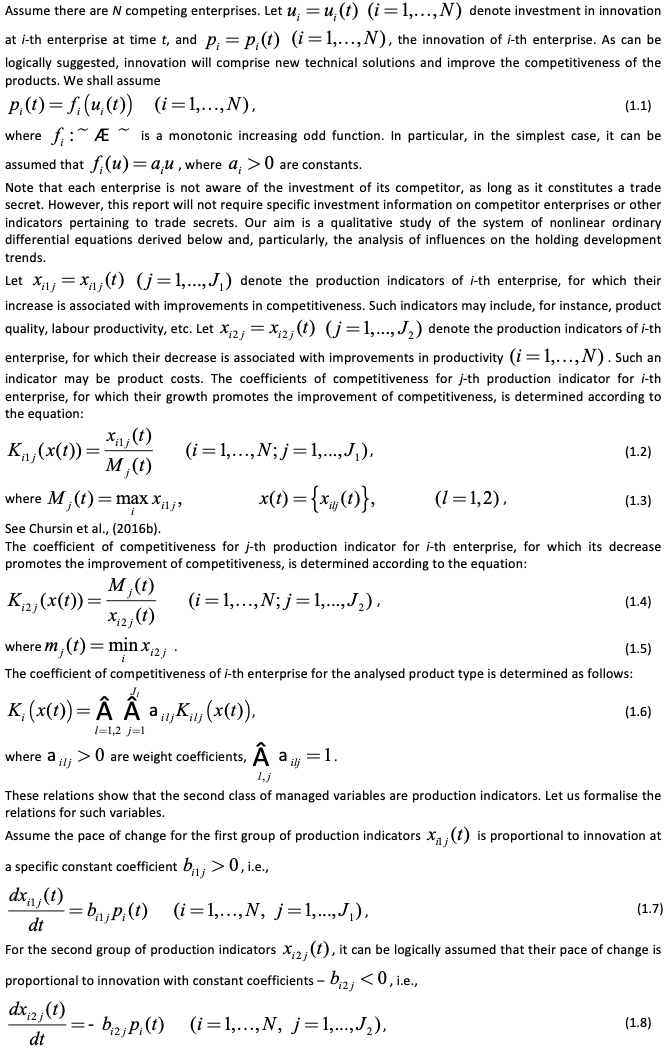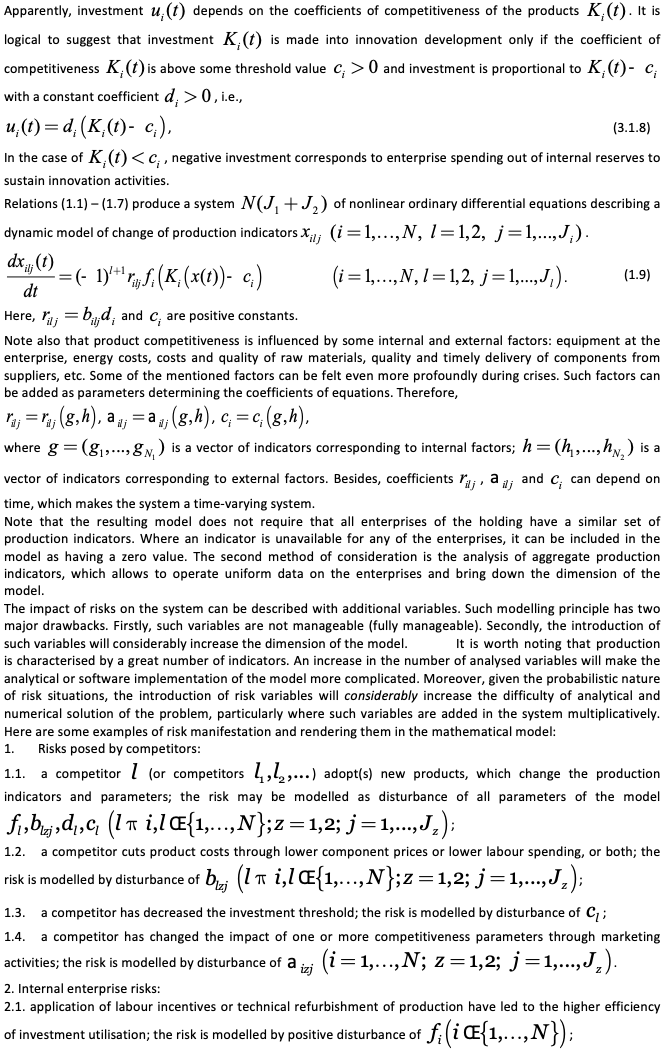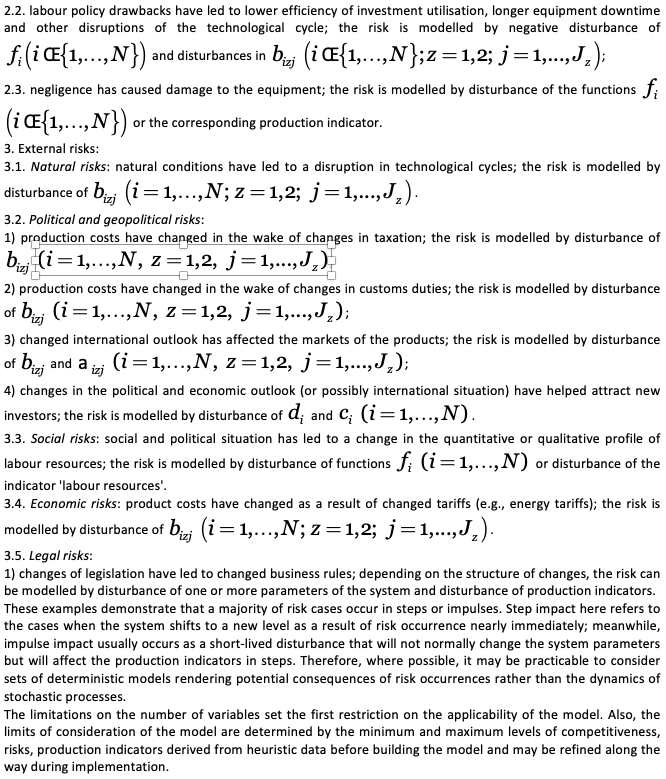

Vol. 40 (Number 28) Year 2019. Page 23
PALUNIN, Dmitry N. 1 & YUDIN, Alexander V. 2
Received: 21/05/2019 • Approved: 04/08/2019 • Published 26/08/2019
ABSTRACT: The paper proposes the main principles of risk management for ensuring balanced development and competitiveness of knowledge-intensive industrial holdings. A dynamic model of knowledge-intensive production considering risks is built for a holding comprising several enterprises. The management criteria for the proposed model are formalised by the methods of decision-making theory and optimisation theory. |
RESUMEN: El documento propone los principios fundamentales de la gestión de riesgos para garantizar el desarrollo equilibrado y la competitividad de las explotaciones industriales intensivas en conocimiento. Se construye un modelo dinámico de producción intensiva en conocimiento considerando los riesgos para una explotación que comprende varias empresas. Los criterios de gestión para el modelo propuesto se formalizan mediante los métodos de la teoría de la toma de decisiones y la teoría de la optimización. |
Forming a risk management system should be approached as a complex process involving the identification and assessment of risks and their main driving factors, as well as their active influence, to bring down their hazard levels. Major approaches to the risk management problem are described in Chursin et al., (2016b); Egorova, (2011); Chursin and Mechar, (2009); Chursin et al., (2016a). Enterprise management, including aspects related to risks, is addressed in Kalmakova, (2014); Koverga, (2014); Chursin and Mechar, (2009). The application of a balanced management system is described in Krasnikova, (2015; Timoshenko, (2018). Based on the nature of the occurrence and the level of manageability, risks can be grouped into two major classes, namely, internal and external risks. The impact of external risks is usually experienced by the whole holding, while internal risks are mostly experienced by particular enterprises. Internal risks are subdivided as internal risks of enterprises and external risks of enterprises, which are, at the same time, internal risks at the holding level. Enterprise-level internal risks include:
The next group is internal risks for the holding but external for the enterprises. In respect of an enterprise, these primarily include risks related to the competition:
Internal risks for a holding include risks related to holding management:
Next, we shall define the main classes of external risks. For better visibility of designating this group of risks as external risks, here are some examples of responses to the possibility of occurrence (or actual occurrence) of a risk situation (Table 1).
Table 1
Major classes of external risks
Classification of risks |
Description of risks |
Methods of management |
Natural risks |
Risks related to natural or social phenomena (force majeure) |
Such risks are not manageable to the extent they cannot be averted. They may be partially manageable, though, as their consequences and the resulting damage can be mitigated via preventive measures |
Political and geopolitical risks |
Risk related to unstable policies of authorities, changes of the global and political situation and legislation governing foreign economic relations |
Such risks are only manageable at the macro level, while management at the holding level should involve analysis and monitoring of such risks to mitigate potential damage in case they materialise |
Social risks |
Risks related to the divergence of interests between social groups and the growth of social activity of the population |
Management involves the substantiation of the social dimensions of the project and effective PR campaigns, as well as focused targeted motivation of labour resources |
Economic risks |
Risks related to the government's economic policy; financial risks arising from crises of the monetary system, inflation; currency risks due to changing exchange rates |
Such risks are only manageable at the macro level, while management at the holding level should involve analysis and monitoring of such risks to mitigate potential damage in case they materialise |
Legal risks |
Risks of losses due to deficiencies of applicable statutory requirements |
Management at the holding level involves monitoring the sound legal operation of the holding and the constituent enterprises, initiation of improvements in the legislative field |
This is an approximate classification since risk management, in most cases, is handled on three levels, namely, by the state, industry (corporation, holding) and enterprise.
Among the main goals of risk management, the following dimensions may be emphasized: maintaining (or increasing) the overall output of the holding; building competitive advantages for the holding's enterprises; market expansion; increasing the share of knowledge-intensive products, etc. That said, the main risk affecting performance on each of the goals and pertaining partially to each of the identified classes of risks is the competitiveness risk.
The problem of managing risks and competitiveness of knowledge-intensive holdings is a multicriteria decision-making problem referring to wide-ranging information and various types of objects, including cases of incomplete information. The methodology of the systems analysis is used to analyse such complex systems. The application of the systems analysis is meant to provide better rationalisation of a decision and expand the range of alternatives while simultaneously establishing the methods to identify inferior decisions (i.e., simultaneous restriction of choice).
A system consists of elements and relations between them. The simplest types of relations are sequential, parallel, and inverse relations. Discerning a system as a group of elements and relations between them determines the system structure. The simplest structure is a tree structure comprising chains of sequential arrangements; it particularly represents clear hierarchical levels.
The following principles of the systems approach should apply in complex systems analysis methods:
The hardware implementation of the systems analysis for our object will be the development of a model as a map of procedures (submodels and operations with submodels) and relations between them. The procedures can be classified as formalised and non-formalised. Formalised procedures are studied by the methods of applied mathematics (mathematical modelling), while non-formalised models correspond to the instances of human factor coming into decision-making (e.g., an expert opinion).
The following constituent parts should be considered in building a mathematical model:
We shall reiterate that the general goals are as follows: maintaining (or increasing) the overall output of the holding; building competitive advantages for the holding's enterprises; market expansion; increasing the share of knowledge-intensive products. These goals can be formalised by adding their respective quantitative values as the indicators of production of the holding and determining, based on their relations, the specific competitiveness coefficients. Accordingly, the main management object in the problem is the competitiveness of the holding, and the first (primary) group of managed variables is the special coefficients of competitiveness determined based on production indicators. Now, we shall build a dynamic model of knowledge-intensive production of a holding comprising N enterprises.



Managing holding development may rely on tangible or intangible production stimuli. Such stimuli may include both direct investment (either in funds or labour resources), legislative initiatives (tax deductions, customs duties), social and moral incentives for the staff, etc. Direct investment can be a convenient management variable (deliberate management). Other stimulation measures create staged or impulse impact; therefore they are best addressed as the system parameters. However, in situations when such stimulation methods are fundamental, they should be added as management variables and the methods of impulse management should be applied to the model.
The notion of system manageability implies the possibility of bringing the system from its initial state to the preset state within a finite amount of time. Studying this issue as part of risk management modelling for balanced development of a holding to ensure its competitiveness will help to determine the limitations of the model applicability (probably as rough approximations). The presence of unmanageable stochastic variables means the model will not be fully manageable. Model stabilization limits and non-stabilizable factors need to be determined. For a risk management model, special focus is warranted on the following aspects:
1) time required to attain a specific level of competitiveness (time constraints for the holding are often determined by global technological progress; it is particularly important for a country with several industries lagging behind by the level of development of scientific and technological base compared to global averages);
2) maximum achievable production indicator levels and coefficients of competitiveness (representing the boundaries of holding development for a fixed time period);
3) fluctuation range for the coefficients of competitiveness (big downside amplitude changes may lead to a bankruptcy of an enterprise of the holding, meanwhile a wide amplitude range itself may signal of the inconsistency of the model with the actual situation);
4) potential risk amplitude (a narrow risk amplitude not only simplifies the numerical implementation of the model but also corresponds to a more attractive production profile for investors).
The model for managing risks and competitiveness was predetermined as a multicriteria one. Building the management criteria for the proposed model is based on the management objectives and formalised by the methods of decision-making and optimisation theory. The proposed basic mathematical management criteria may include the following:
A gauge to evaluate the quality of management will be the quality of compliance with a specific criterion or a weighted total of the quality of attainment of management criteria; the weights should be assigned by expert opinion based on the level of significance. For setting the functional profile of a management optimisation problem for the holding, a criterion should be identified, which should contain a weighted characteristic including the estimate of the total output of the holding, the percentage of knowledge-intensive production, the minimum required production volumes of certain product types, etc.
The building of functionals to determine such measures and the methods of finding optimum solutions for such functionals are studied in the optimisation theory and the optimal control theory.
The problems of finding optimum solutions can be classified depending on:
Here is an example of a possible target function and its application. Let denote a target function, e.g., the total cost of the holding's output and , the minimum acceptable level of the output cost. If at the moment t the value is , the holding management should make decisions to bring down the thresholds of borrowed investment for the enterprises with declining production levels. This is attained primarily through the reduction of taxes for investors of such enterprises, the extension of loans on preferential terms, etc. Moreover, such a situation warrants measures for more efficient financing policy and developing innovation (increasing the coefficients and the derived ) and improvement of innovation implementation in the production of knowledge-intensive products (increasing coefficients ).
Given the multicriteria management approach and the presence of several diverse manageable variables, the model of managing risks and competitiveness will probably correspond to a multidimensional stochastic target function, which will probably be materially nonlinear due to the complexity of the constituent relations of the system. This leads to the need to structure the management process.
The creation of a mathematical model of risk management in a holding should be based on mapping a graph of managerial decision-making, with nodes representing the submodels of risk management and (or) competitiveness and procedures (operations) over such submodels. As long as the discussed complex system comprises all three types of the basic relationship patterns, its structure will not be a tree structure but will comprise complex cycles. The relations between the parts of the model will operate based on common shared data, which can represent the parameters of one submodel and the variables of another submodel. Stochastic components are rendered as quite simple submodels of a linear or quasi-linear type, with the requisite designation of the scope where such linearization holds.
The graph of the management model will include the nodes of non-formalised decision-making procedures. The higher the level of elaboration of the model, the less non-formalised procedures it contains. Complete elimination of non-formalised procedures is not practicable at the current level of computing technology. It comes with the nondeterministic and materially nonlinear nature of the model, which inevitably results in building a quite complicated computational process. Meanwhile, the identification of an optimum solution (optimum strategy) may come at a greater cost compared to the resulting benefit from the application of such a strategy in contrast to the benefit of a proximal strategy. The discontinuation of the computational process in the optimisation may be triggered either via an informal procedure (decision-making by the user in a computer dialogue) or via an automated procedure, in which case the formalisation of the discontinuation trigger is required by the application of an additional criterion.
Refining the parameters and values of the variables (both manageable and management variables) can be achieved by multiple repetition of the computer experiment until a near-threshold state is attained, or by overdetermination of the overall model, i.e., where specific data is considered in several independent models and the findings concerning the real condition of the system are derived through the comparison of thus produced results. The principle of overdetermination was developed in the system survivability theory; it allows to estimate and mitigate both the error of computational methods and the error of building the submodel itself.
This paper was financially supported by the Ministry of Education and Science of the Russian Federation under the project No.26.1146.2017/4.6 “Development of Mathematical Methods to Forecast Efficiency of Using Space Services in the National Economy”.
Chursin, A.A., Mechar M. (2009). Vneshneekonomicheskaya deyatel'nost' organizatsii [International economic activity of organisations]. Moskva, Bratislava: Merkurii Publishing House (Bratislava).
Chursin, A.A., Okatiev N.A., Grosheva P.Yu. (2016a). Podkhody k otsenke effektivnosti finansovo-ekonomicheskikh instrumentov resursnogo obespecheniya innovatsionnogo razvitiya predpriyatii vysokotekhnologichnykh otraslei [Approaches to efficiency evaluation of financial and economic tools of innovation development at enterprises of technology industries]. Biznes v zakone. Ekonomiko-yuridicheskii zhurnal. [Business in Law. Economic and Legal Journal], 6, 60-62.
Chursin, A., Tyulin, A., Yudin, A. (2016b). The model of risk assessment in the management of company's competitiveness. Journal of Applied Economic Sciences, 11(8), 1781-1790.
Egorova, O.S. (2011). K voprosu o sbalansirovannom razvitii innovatsionnogo i investitsionnogo tsiklov predpriyatiya [Revisiting balanced development of innovation and investment cycles of enterprises]. Transportnoe delo Rossii [Transport Business of Russia], 10, 48-49.
Kalmakova, N.A. (2014). Operativnoe i strategicheskoe upravlenie ustoichivym i sbalansirovannym razvitiem promyshlennogo predpriyatiya [Operational and strategic management of sustainable and balanced development of industrial enterprise]. Ekonomika i sotsium [Economy and Society], 4-3(13), 290-299.
Koverga, S.V. (2014). Kontseptsiya upravleniya sbalansirovannym razvitiem promyshlennykh predpriyatii [Concept of balanced development management of industrial enterprises]. Ekonomika promyshlennosti [Economy of Industry], 3(67), 43-56.
Krasnikova, A.V. (2015). Povyshenie effektivnosti upravleniya ustoichivym razvitiem predpriyatiya na osnove primeneniya sbalansirovannoi sistemy pokazatelei [Improving efficiency of sustainable development management of enterprise based on application of balanced system of indicators]. Ekonominfo [Econominfo], 23, 43-47.
Timoshenko, P. N. (2018). Kontseptsiya effektivnogo upravleniya sbalansirovannym razvitiem predpriyatii promyshlennosti [Concept of efficient management of balanced development of industrial enterprises]. Rossiiskoe predprinimatel'stvo [Russian Journal of Entrepreneurship], 19(1), 141-152.
1. Deputy CEO for Finance and Economics, JSC “Ruselectronics”, Russia. E-mail: palunin_dmitry@mail.ru
2. Department of Applied Economics, RUDN University, Russia